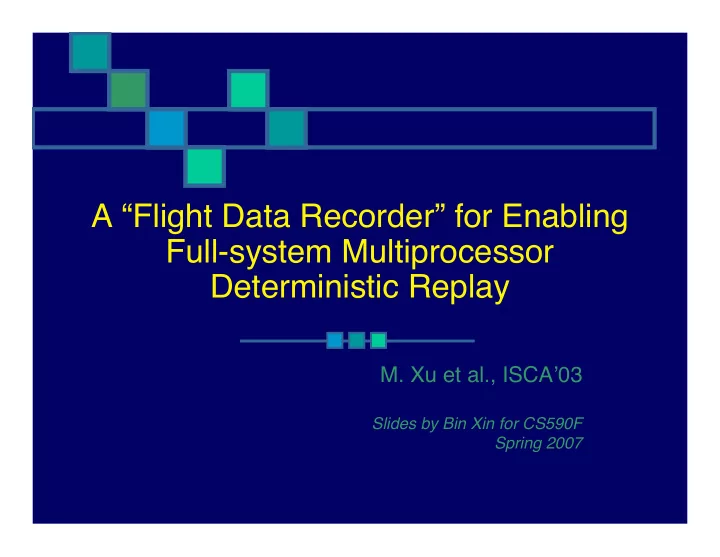

A “Flight Data Recorder” for Enabling Full-system Multiprocessor Deterministic Replay M. Xu et al., ISCA ’ 03 Slides by Bin Xin for CS590F Spring 2007
Overview Faithful replay of execution essential for debugging Non-determinism outcome of multithreaded program need to be recorded Overhead too high w/ existing method Other issues: non-repeatable inputs (full system replay) Hardware based approach Impl. piggybacks on cache coherence msgs 1
Related work Bacon and Goldstein[2]: HW based replay scheme for multiprocessor program Netzer[15]: transitive reduction technique Avoid recording race outcomes that are implied by others Reducing log size for inter-thread mem. op. orders 2
Components Initial replay point: checkpointing Non-determinism outcomes: data races Dealing with I/O Non-repeatable input from remote source Interrupts and traps Treatment of DMA ops Replayer 3
Checkpointing Initial replay state include architecture state of all processors TLB, registers, cache, mem. Technique from backward error recovery A series of checkpoints saved, recycling the oldest checkpoint ’ s storage Replay from the oldest when triggered (e.g. crash) 4
Checkpointing (cont.) Requirements “always on” dictates low overhead Operate with cache coherence shared-memory multiprocessor E.g. SafetyNet[26] Optimization Only update bursts logged on-chip between checkpoints Logs are then zipped (w/ HW) and saved to main mem., or disks; 5
Data races Log non-deterministic thread interleaving I.e., data race outcomes (arcs, head, tail): j:25 → i:34 Data race Instructions from different thread/processor operate on the same memory location, one of them is write Assume sequential consistency as the underlying memory model All instructions form a total order consistent with program order of each thread Under this total order, a read gets the last value written 6
Recording data races: concepts Trivial solution: to record orders of all pairs of dynamic instructions, but Instr. access different mem. locations are independent, thus order can be omitted Certain orderings are implied by others Three step solution From SC to word conflict (data races at word level) From word conflict to block conflict Blocks are what cache coherence protocol works on From block conflict to transitive reduction Optimization as outlined by Netzer 7
Recording data race: opt. 8
DSM: SGI origin system 9
Cache coherence protocol:MOSI Directory based cache coherence protocol for DSM multiprocessor systems ( MOSI slightly different than shown here ) M: modified E: exclusive S: shared I: invalid O: owned 10 Illustration by A. Davis
Recording data race: algo. - Coherence msgs reveal the arcs in SC order - Directory protocol reveal all block conflict arcs 11
Recording data race: reality Idealized hardware Cache size == memory size No out-of-order issue/commit at each processor No counter value overflow Realistic hardware Send observation: head can lie anywhere [CIC[b], IC] Receive observation: IC+1 can be used as tail, even semantically not Speculative exec., finite cache, unordered interconnect, integer overflow Only works for SC memory model Implemented hardware 12
I/O replay Program I/O (from devices) Log non-reproducible source, e.g. remote source I/O nothing more than load/store to some special memory segment Log load value, not stored value Interrupts and traps Log interrupt vector (e.g. source), and instruction count of processor Traps are asynchronous, not logged; can be reproduced by replayer DMA: modeled as a pseudo-processor Log store value, read value regenerated during replay 13
Implementation: FDR1 14
FDR1 (cont.) About 1.3M on-chip hardware: 15
Implementation (cont.) Simulation Virtutech Simics, SPARC V9, 4-processor system, sufficient to boot Solaris 9 In-order, 1-way issue, 4GHz processor w/ 1GHz system clock MOSI cache coherence protocol 2D-torus interconnect W/ and w/o FDR1 Checkpoint every 1/3 second, for a total of 4 snapshots Capable of replay 1 ~ 4/3 seconds ’ execution 16
Replayer Not the focus of this paper Basic requirements Initialize register/cache/mem. Replay intervals for each processor A logged race outcome i:34 → j:18 will pause processor j at instruction count 18 until processor i reaches instruction count 34 Additional requirements for debugging Interface to a debugger What about states not inside memory, but needed by debugger 17
Evaluation: correctness Whether FDR1 can do deterministic replay Tested w/ a multi-threaded program whose final output sensitive to the order of its frequent data races Compute a signature using a multiplicative congruential pseudo-random number generator Each of ten thousands of runs produce unique signature Benchmarks OLTP (DB2 v7.2 + TPC-C v3.0), 24 user; Java Server (Hotspot 1.4.0 + SPECjbb2000), 1.5 wh/proc; Static web sever (Apache 2.0.36 + SURGE), 15 users/proc; Dynamic web server (Slashcode 2.0 + Apache 1.3.20, mod_perl 1.25+MySQL 3.23.39), 12 users/proc; After warm-up, run for 3 checkpoints 18
Evaluation: time overhead 19
Evaluation: space overhead 20
Summary A HW based design for enabling full-system replay on multiprocessor system (aimed at 1 second) Implementation piggybacks onto cache coherence protocol W/ infrequent checkpoint, simulation shows time overhead not significant (<2%) W/ compression, simulation shows space overhead acceptable (34M, or 7% of system mem.) 21
Discussion Consistency issue of the initial replay state Can such solution fits well onto cache coherence messages Other issues in real system w/ each processor running multiple processes Not a replacement for software based debugging tools Consider when bug cause and crash point are separated long enough 22
Recommend
More recommend